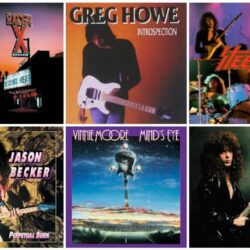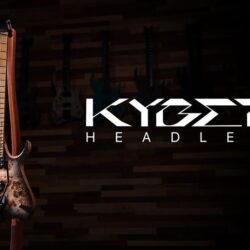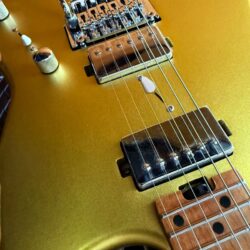Q&A and Full Album Stream: Dazzling Killmen Reissue Debut ‘Dig Out The Switch’
Hear the remastered version of Dazzling Killmen’s Dig Out The Switch! And read our conversation with guitarist and vocalist Nick Sakes and drummer Blake Fleming about making the album, reuniting, surviving cardiac arrest, and more.
The post Q&A and Full Album Stream: Dazzling Killmen Reissue Debut ‘Dig Out The Switch’ appeared first on Decibel Magazine.

A Guide to Shrapnel Shred
Chops: AdvancedTheory: IntermediateLesson Overview:• Work through sweep arpeggios in the style of Jason Becker.• Add more chromatic notes to your improvised solos.• Make your riffs more compelling with unexpected rhythmic subdivisions.Click here to download a printable PDF of this lesson’s notation. Shrapnel Records introduced the world to some of the most virtuosic rock and metal guitarists to have ever plugged into a high-gain amp. Starting in the ’80s, an era that has subsequently become infamous for guitar gods, Shrapnel’s founder Mike Varney carefully selected the cream-of-the-crop players for his unique record label.Some Shrapnel alumni are best known for sweep picking, others for insane alternate picking, and yet others for emphasizing legato fretwork. But all of them are known for playing a lot of notes in a very musical way. What made many of these players great, in my opinion, is that each took a unique approach to playing and writing within the fairly specific “shred” genre. Want to acquire some tricks of their trade? Let’s take a look at key ideas and techniques used by several of Shrapnel’s heaviest hitters.Most people associate Shrapnel guitarists with technical lead playing, but before we go there let’s first visit the often-overlooked art of playing rhythm. In my opinion, Paul Gilbert and Bruce Bouillet of Racer X were absolute masters of creating rhythmically exciting and unexpected metal riffs. These were often based on strong rhythmic hooks that included subdivisions and interwoven exchanges, and took surprising aural twists and turns.Ex. 1 is a Racer X-style riff in A minor that illustrates the basic idea of taking one rhythmic pattern and throwing in surprise subdivisions. This riff’s main rhythmic pattern is based on three-note groupings of 16th-notes. In the first measure we encounter a new subdivision on beat 4. Hear how those 32nd-notes surprise the ear? It’s a great example of what Racer X was known for. Another example of this effect is in the riff’s second fill. We have a 16th-note triplet run to wrap up the first repetition (starting on the “and” of beat 3 in measure 2), and again, the change in subdivision from the main 16th-note pattern creates an additional rhythmic twist.Click here for Ex. 1Now that we’ve had a dose of rhythmic content, let’s shift over to the kind of lead playing that makes many listeners’ jaws drop. Because he introduced pop and R&B-inspired chord changes and funky rhythms to what was fundamentally a hard rock and metal label, Greg Howe is arguably one of the most distinctive Shrapnel artists. To make things even more interesting, he favored an innovative tapping technique and infused his playing with chromatics.Inspired by the record Introspection, Ex. 2 is a Greg Howe-style lick over a series of dominant 7 chords. Hear how the chromatics are interwoven between E7 and B7 chord tones on the weak parts of the beat? This is a common jazz guitar technique, but it’s made very Howe-ish thanks to Greg’s grooves, feel, and note choices. Next over A7 comes one of Greg’s most famous tapping techniques. This line also demonstrates his “hammer-on from nowhere” technique, which means that the hammer-on note isn’t approached by a previously picked note. Finally, we have another of Greg’s famous tapping techniques over the F#7. Here, we take three-note-per-string scales and instead of picking every note or playing full-on legato, use a hammer-hammer-tap pattern to cover the ascending phrase.Click here for Ex. 2Another Shrapnel powerhouse is Tony MacAlpine, who is famously known for his blazing picking and his blend of classically inspired themes and contemporary instrumental music. Ex. 3 pays tribute to his approach to arpeggios.The opening phrase is one of my favorite Tony-isms. We’re creating a major 7 arpeggio, in this case Dmaj7, by only using the lowest two strings. Keep in mind that there’s absolutely no picking here—it’s strictly legato and tapping. But the real interesting thing about this kind of line is the context in which Tony often uses it. Here, we’re in a Bm tonality, so we can use a D major arpeggio (Bm’s relative major) and still stay in the key.Click here for Ex. 3We’ve explored a variety of tapping and arpeggio ideas, but haven’t yet encountered one of the most common staples of the Shrapnel guys: alternate picking licks! Many of the Shrapnel guitarists are well known for playing long, scalar runs in which they pick each note. If used wisely, this can be one of the simplest ways to enhance your playing, as these runs are mostly pattern-based and primarily built on the three-note-per-string scale fingerings. A simple alternate-picked line in B minor, Ex. 4 starts with a six-note scale shape that’s copied across three octaves. You’ll find this fragment (the first three beats of the first measure) on many Shrapnel albums. Keep in mind that strict alternate picking is crucial for the accuracy and cleanliness of a lick like this, so be sure to practice it slowly.Because these lines work so well in the three-note-per-string fingerings, they’re often conducive to some sort of triplet subdivision. The kicker with such licks is that they’re very pattern-based and can end up sounding too much like an exercise. Use them wisely and musically. Click here for Ex. 4And last but not least, what would a column on Shrapnel be without a mention of the legendary Jason Becker? For dedicated shredders, his playing and spirit need no introduction, but if you need one, check out this trailer for the excellent documentary Not Dead Yet. Ex. 5 is a workout in Becker-style sweep arpeggios. One point that was unique about Jason’s particular approach to sweep picking is that he extended certain arpeggio shapes further than other players did. In this example, all of the shapes extend down to include two notes on the 5th string. It’s fairly rare to see the Bm and E shapes extend down that far, but that’s part of Jason’s nuanced magic. The key to successfully playing sweep arpeggios lies in the picking pattern. It’s always a specific, non open-ended pattern that isn’t as simple as just constant downstrokes and upstrokes. A hammer-on or pull-off is included every time there’s two notes played on the same string. Click here for Ex. 5Keep in mind that playing anything cleanly and accurately lies in practicing very slowly, in time with a metronome. These guys were all masters of fast playing, but I believe they were standouts because they used their chops in clever and musical ways, and that composition was their first priority. So when you’re sitting down with your metronome to blaze through these licks, just remember that music comes ahead of technique.Racer XThis blazing live performance of Racer X’s “Scarified” from 1988 illustrates how Paul Gilbert and Bruce Bouillet varied the rhythms within their warp-speed riffs.Greg HoweGreg Howe improvises an incredible solo over his tune “Come and Get It.” Check out 0:45-0:48 for a great example of one of his signature tapping techniques.Tony MacAlpineHere’s Tony MacAlpine playing “Pyrokinesis” with an excellent view of his fretboard. Marco Minnemann plays the drums on this track and MacAlpine plays everything else. Look for his tapped arpeggios sequences and notice how he weaves them into both the melody and the solo.Jason BeckerThe legendary Jason Becker performs a dazzling mix of feisty, extended-range arpeggios in this clip from a guitar clinic in 1989.
Read more »
Kiesel Unveils Kyber Headless and Masvidalien MIII Models
Kiesel Guitars has introduced the two newest models in the company’s iconic line of custom-built instruments: the Kyber Headless and Masvidalien MIII now join the lineup of Kiesel’s premium US-made instruments.Designed to excel in a variety of musical styles, the versatile Kyber Headless is available in 6, 7, and 8-string configurations, standard or multiscale. Key features include: 7 different body woods for customization25.5” scale length, 15 different fretboard woods for customization, 24 fretsOver 100 different pickup configurationsKiesel-Designed locking nut, headpiece for hanging, optional body scoopsThe Masvidalien MIII is the debut Kiesel signature model from Paul Masvidal, guitarist and composer known for his work with Cynic, Death, Æon Spoke, and Mythical Human Vessel.Built in Kiesel’s California factory, the MIII was designed with strength, resonance, and playability at its core. Inspired by Kiesel’s Kyber model, which Masvidal was already connected to, the MIII began as a natural extension of that instrument but quickly evolved into something uniquely its own, a hybrid guitar that expands on the Kyber’s spirit and opens new creative ground.Key features include:Woods: 5A Poplar top with a Swamp Ash body, Buckeye top with a Roasted Swamp Ash body25.5”-26.5”, Fretboard woods: Ebony, Richlite Diamond, Roasted Maple, Royal Ebony, and Roasted Birdseye Maple, 24 FretThe brand-new Focus pickup, a humbucker made from two blade-style single coils that offers tighter and more precise tonesThe Hybrid carbon fiber/wood neck, the Barbury Castle Crop Circle inlay, Headpiece for hanging,Like other Kiesel models, the new Kyber Headless and Masvidalien MIII are available in a wide range of options for unique customization. Players can select their favorite finish, tonewoods, electronics and hardware to create the guitar of their dreams…expertly crafted in Kiesel’s Southern California custom shop.Kiesel’s new Kyber Headless is available for street pricing starting at $1,599. The new Masvidalien MIII is available for street pricing starting at $3,199. For more information visit kieselguitars.com.
Read more »
Full Album Stream: Nicolas Cage Fighter –I Watched You Burn
Hear Aussie deathcore quartet Nicolas Cage Fighter turn up the heat on I Watched You Burn.
The post Full Album Stream: Nicolas Cage Fighter –I Watched You Burn appeared first on Decibel Magazine.

Steve Morse Band Announces Brand-New Studio Album
The Steve Morse Band has announced details of their brand-new album, Triangulation, which will be released on November 14 via Music Theories Recordings (Yngwie Malmsteen, Ayreon, Paul Gilbert, Vandenberg). To celebrate, they have unveiled the official video for their new track, “Break Through.”“Break Through” is the first new music since the release of 2009’s Out Standing In Their Field. Talking about the track, Steve Morse shares, “This may start with a guitar riff, but the bass carries the melody. It’s just a great feel to play over, and a positive vibe to start the album.”Whenever we think of the greatest guitar players of all time, Steve Morse is a name that’s always in the conversation. This album sees Morse teaming up once again with Dixie Dregs, Steve Morse Band, and Flying Colors bassist Dave LaRue, with Van Romaine [Steve Morse Band/Enrique Iglesias] joining on drums.Steve beams, “Dave and Van have been the bedrock of this trio, and this recording shows why. These guys are unique and incredible musicians on their own, and together, our chemistry is magical. While making the album, we played together, working through parts, riffing off each other, and collaborating on arrangements. I’d bring an idea, and hear it instantly — and then hear it improved. We made this album together, and you can hear it.”There are also some stellar guest features, from Eric Johnson’s majestic contributions to “TexUS” and John Petrucci bringing his inimitable progressive metal thunder and, of course, Kevin Morse joining his father on “Taken by an Angel.”.Executive producer Bill Evans noted, “The compositions are among Steve’s best. And audiences can finally hear every detail of Van and Dave’s performance…the band’s collaborative musicality.” Steve added, “Brian captured me brilliantly, and Carl Roa created more sonic and performance clarity than we’ve ever had.”Morse started his career in the mid-1970s, playing mind-melting jazz-rock with The Dixie Dregs, which earned him multiple Grammy nominations in the process. The following decade, he formed the Steve Morse Band, grabbing an additional Grammy nod, and joined arena heavyweights Kansas, before being recruited by rock and roll originals Deep Purple in 1994. And despite being in one of the world’s biggest bands, he continued to innovate in other projects like Living Loud, Angelfire, and Flying Colors – as well as guitar supergroup G3 – showing the world just how much versatility there was in those magic fingers. He announced his departure from Deep Purple in 2022, choosing to care for his wife, who passed away in 2024, by that point having become their longest-serving guitarist.Naturally, the last few years have been the most personally traumatic of his life, which is perhaps why this year’s creative comeback with the new Steve Morse Band album Triangulation embodies the spirit of a master returning to do what he does best. Its nine tracks are a thrilling ride through the mind of a musician who seemingly knows no bounds, crossing over into a cornucopia of sounds and styles from funk and blues to classical and metal.“The album title Triangulation comes from the concept of aviators, navigators, and sailors looking at two points to pinpoint their exact location at a specific moment in time,” says Steve. It’s a geographical concept that also applies to human life on a broader level, and given the journey Morse has been on in recent years, it’s only natural that he’s been on a path of self-discovery and reflection.Perhaps the most poignant of the nine tracks is “Taken By An Angel” – a tribute to Steve’s beloved wife Janine. Steve left the music world behind to care for her, remaining by her side until her final days. “That song is new territory for me,” explains Morse. “It was put together for my late wife’s memorial service, with my son Kevin playing along. It brought tears to many folks’ eyes because Janine was a huge part of my life and career. People knew her from the Steve Morse Band tours. She was the smiling face opening CDs for me to sign, selling t-shirts, listening to people’s stories in the crowd, and taking photos for VIP visits.”After all the heartache and anguish of the last few years, you can’t help but feel grateful Morse is once again ready to share his creative genius with the world around him. Given his stature among the guitar community – often lauded as ‘your hero’s hero’ in the same way people spoke about Jeff Beck – his creative return marks a new phase of inspiration and brilliance. In that sense, you can tell the release of this record means a lot to him.The band hits the road in October bringing the new repertoire to the stage. Steve Morse shares, “Every generation or so, we put out a new album, and the time is now! We’ll be doing new material on stage, and have enlisted a special guest, Angel Vivaldi, to allow us to better perform some of the layered tunes in concert. Excited to have a bigger sound and new material! See you on tour!” Van Romaine offers, “I am so thrilled for this brand new major Steve Morse Band chapter with new tour dates and an album that was so much fun to record with Steve and Dave LaRue, and a couple special guests. While music is always subjective this Triangulation album is such a gem to me on many levels.”Upcoming Appearances are:10/09 Louisville, KY Headliner’s10/10 Nashville, TN CMA Theater10/12 Charleston, SC Charleston Music Hall10/13 Atlanta, GA Variety Playhouse10/14 Charlotte, NC The Neighborhood Theatre10/15 Raleigh, NC The Rialto Theatre10/16 Annapolis, MD Rams Head On Stage10/18 Elkton, MD Elkton Music Hall10/19 Lititz, PA Mickey’s Black Box10/20 Red Bank, NJ The Vogel10/21 Sellersville, PA Sellersville Theater10/23 Somerville, MA Somerville Theatre10/25 Cohoes, NY Cohoes Music Hall10/26 Ridgefield, CT Ridgefield Playhouse
Read more »
IK Releases Brown Sound 82/84
IK Multimedia releases the Brown Sound 82/84 Signature Collection for TONEX, the third and final installment of the limited TONEX Brown Sound series. This collection features 83 carefully crafted Tone Models, including several amp-only captures for use with your favorite IRs or running through a real cab on stage.As the push for radio-ready hits grew stronger, the Brown Sound became tighter, more refined, and more polished without losing its iconic edge. Users will discover both authentic recreations and thoughtful variations to reflect different theories about how these legendary tracks were recorded.1982 Tone ModelsThe ’82 sessions introduced a brighter, more layered tone while preserving the core character of the previous recordings. The G12-65 speaker remained key to the sound, delivering a tight low end, warm midrange, and a smoother, less spiky high end than the earlier Greenbacks. Recorded in Amigo studios, changes in mic placement and outboard gear added polish and dimension, resulting in a more refined studio sound.1984 Tone ModelsThe ’84 sessions marked a leap forward in tonal precision and production quality. Tracked and mixed at a newly built studio in Coldwater Canyon, the sound became more controlled and processed, yet still retained the grit and energy of earlier recordings. The suspected use of Telefunken EL34s likely contributed to the added warmth and mid-forward presence, while amp tweaks and precise Variac adjustments gave each track its own tonal identity.The Amp: “The ONE”At the heart of the Brown Sound 82/84 collection is “The ONE” – a meticulously crafted Marshall-style amp built from the ground up with the exact same spec as the infamous 1968 Super Lead serial number #12301, including crucial mods that capture the DNA of the early brown sound like no other amp model.No Tone UnturnedEach Tone Model was built using controllable levers like Variac voltage, cab voicing, mic geometry, and parallel load, with options spanning different voltages, speakers, and pickups to reflect the shift from ’82 to ’84. All models are level-matched, offered with or without parallel load, and captured raw without post-processing for authentic, period-correct amp tones.Ready to PlayAs with all collections in the series, these Tone Models were crafted using period-correct gear and capture techniques to recreate the final two albums of that era genuinely. Each Tone Model reproduces the recorded album tone in exquisite detail, offering an ideal foundation for adding time-based effects—either within TONEX or through a favorite pedal.Pricing and AvailabilityThe Brown Sound 82/84 Signature Collection is now available via ToneNET and within any version of TONEX for Mac/PC at $/€99.99.*TONEX Brown Sound 78/79 – $/€99.99* – Includes 50 Tone Models.TONEX Brown Sound 80/81 – $/€99.99 – Includes 73 Tone Models.TONEX Brown Sound 82/84 – $/€99.99 – Includes 83 Tone Models.TONEX ONE Brown Sound Limited Edition – $/€249.99 – Available in white, red, or yellow. Includes Brown Sound 78/79 and a choice of one other Brown Sound collection (a $/€199.98 software value). Existing Brown Sound 78/79 users will receive a $/€50 discount at the IK store.TONEX Brown Sound Anthology Collector’s Limited Edition – $/€599.99 – Shipping now. Box set includes all three colors of TONEX ONE (white, red, and yellow) plus all three Brown Sound Signature Collections (78/79, 80/81, and 82/84). Limited to 200 units worldwide.*Pricing excluding taxes.For complete details and information about the Brown Sound Anthology collections and pedals, and to hear the tones, visit:www.ikmultimedia.com/tonex-brown-sound
Read more »
Find Your Voice
Over the years I’ve often been asked for advice about how to “get into the business” of either the playing or building of guitars. Despite my reluctance to toss anyone into the hellhole pit that is either of these two endeavors, I do my best to help. That isn’t to imply that building guitars or playing music isn’t satisfying—it most certainly can be. In fact, many of us have built fulfilling and profitable careers in both of these trades, not to mention made lifelong friends. What are you hoping for? Is this going to be your job, with hopes that it won’t seem like drudgery? Do you just like to mess around with gear and wonder what it would be like to do it for pay? Like almost everything in life, it’s the managing of expectations that’s at the heart of the matter.If it’s money you’re after, there are people more qualified to guide you than me. Yes, I’ve managed to scrape together a living while seemingly avoiding the grind of a “normal” job, but it hasn’t been a cake walk. I’d be afraid to add up the hours I’ve spent doing things I would have rather not had to do. I call it the 80/20 rule. You spend 80 percent of your time doing stuff you’d rather not do, and 20 percent doing the things you love—and I’m being generous here. If that seems like a normal job to you, you’d probably be correct. But despite all of that, let’s talk about how to get started anyway.
If you want to follow your muse and cut your own path, approach things like an artist who dropped out of business school. Be prepared to use your truncated education on 80 percent of the work, and let your freak flag fly on the 20 percent that makes you be you. Not everything you create will solve problems and answer questions for your customers and fans, but that’s not the point—at least in the creative part. Don’t worry, your rational self will be waiting down the line to reveal the cold hard truth later.
“Being a creative person is a series of trial-and-error episodes as much as any kind of formal schooling.”In art critic Jerry Saltz’s book How to Be an Artist, he spells out how to discover your path—a sort of step-by-step guide to making the right kind of “mistakes” that bring you to the place where you know and understand how to be uniquely you. In fact, you might want to stop reading my drivel and go buy his book now. That gets us both off the hook.Saltz’s process seems very familiar to me. You see, being a creative person is a series of trial-and-error episodes as much as any kind of formal schooling. It’s good to learn the history of your craft—all of it. Learn the way artists look at the world. Try to imagine how the constraints of what has come before benefit and hold us back. You can’t break the rules unless you know them and why they exist. There are conventions that should be questioned, and others that are the bedrock of the game you are playing. Learn how to tell the difference.
Maybe you’ve heard that there are only seven basic story arcs: overcoming the monster, rags to riches, the quest, voyage and return, comedy, tragedy, and rebirth. But we all know that within these themes there are infinite possibilities. That’s your ticket. That’s where your personality and character carve out your unique vision. I like to think of guitars (and songs) as story arcs. There may be only a few archetypes, and almost everyone follows them, but what’s important is the way you tell the story. On a guitar, you shouldn’t just decide to put a toggle switch in the middle of the fretboard because you want to be different, but you can decide to make that switch do something that hasn’t been done. I usually stop at that point and ask the 80 percent dude in me if this will actually help anyone, although I am free to ignore the answer if it helps to tell the story I am telling.
In the end, if you pay attention to what you like, the story you are telling will be a reflection of you. When that story makes sense to your audience, too, you’re in business. And that’s how you make a life as an artist
Rock ‘n’ Roll Fantasy Camp Celebrates 30 Years with Legendary The Who Icon Roger Daltrey
FOR RELEASE: WEDNESDAY, SEPT 10, 2025 Rock ‘n’ Roll Fantasy Camp Celebrates 30 Years with Legendary The Who Icon Roger Daltrey in Miami, FL, January 29 – February 1, 2026. To Kick Off the Celebration, Alice Cooper and Rob Halford (Judas Priest) Headline Two Camps in Phoenix, AZ This November, and Felix Cavaliere (The Rascals), […]
The post Rock ‘n’ Roll Fantasy Camp Celebrates 30 Years with Legendary The Who Icon Roger Daltrey first appeared on Vintage Guitar® magazine.

System of a Down’s Daron Malakian Rig Rundown
The metal giants return to the stage with a show powered by gold-and-black axes and pure tube power.Except for two new singles in 2020, alt-metal icons System of a Down haven’t released new music in 20 years. But luckily for their fans, System—vocalist Serj Tankian, guitarist/vocalist Daron Malakian, bassist Shavo Odadjian, and drummer John Dolmayan—took their catalog of era-defining, genre-changing hard-rock haymakers on tour this year across South and North America.PG’s Chris Kies connected with Malakian onstage at Soldier Field in Chicago ahead of System’s second show at the football stadium. Malakian and his tech, Patrick Lachman, explained how some color-coded Gibson, Ibanez, and Friedman gear give Malakian the fire he needs to burn through the band’s legendary set.Brought to you by D’Addario.SG With SDsThis Gibson SG is brand new and “hot off the presses,” per Malakian’s tech, Lachman. Built in Gibson’s Custom Shop, it’s got Seymour Duncan Custom Shop pickups. On this run, he starts shows on this guitar, and will typically switch things up after about 10 songs.Malakian plays custom, extra-pointy Dunlop picks, and runs all his axes with a custom set of Ernie Ball strings (.010–0.50). System’s catalog, and therefore Malakian’s guitars, are predominantly in drop-C tuning.Freeze!Next up during the set, Malakian will turn to his iconic Ibanez Iceman, one of his most heavily leaned-upon toys during this tour. This one has black “secret ninja binding,” his tech quips, virtually invisible to all but Malakian. It’s wired with Seymour Duncan Custom Shop Pearly Gates pickups.B.Y.O.V.Malakian always liked how Albert King’s Flying V looked with its Les Paul-style headstock, so when Gibson was making him a V, he requested that it be outfitted with the same look. This one’s rocking a pair of Seymour Duncan Saturday Night Special pickups.Semi-Hollow StarThis Gibson ES-335, dressed in the same black-and-gold scheme as all of Malakian’s guitars, also came fresh from the Custom Shop for this run of shows.Old and New, All TubeMalakian doesn’t have anything against modeling technology, but he prefers to keep things old-school. He runs two generations of Friedman BE-100 heads at the same time: The newer BE-100 Deluxe head (below) is used for dirty tones, while the first-gen BE-100 (above) stays dialed for cleans. They’re connected to two Marshall 4×12 cabinets onstage, dedicated to either the clean or overdriven signals. The speakers are Celestion G12M-70s.Loaded onto Malakian’s rack above the amp heads are a Shure AD4Q, Radial JX 44, MXR Smart Gate Pro, Voodoo Lab GCX, AmpRx Backline, and Furman PL-Pro DMC.Daron Malakian’s PedalboardMalakian’s switching is handled backstage by his Scars on Broadway bandmate Orbel Babayan via this board. In addition to a Voodoo Lab Ground Control Pro switcher, Akai MPK Mini, and Scarlett Focusrite interface, the board is dead simple, with just an MXR Phase 90 and Boss DD-6 delay. No dirt pedals needed; all Malakian’s drive comes from the Friedman. A Voodoo Lab Pedal Power 2 Plus fires up the affair.MXR Phase 90Friedman BE-100 DeluxeFriedman BE-100Marshall 4×12 cabsErnie Ball Custom Set (.010-0.50)Gibson Flying VGibson SGGibson ES-335Ibanez IcemanShure AD4QRadial JX 44MXR Smart Gate ProAmpRx BacklineFurman PL-Pro DMC
Read more »Album Premiere: YOTUMA – ‘The Final Void’
Brutality meets craftsmanship in The Final Void, the crushing new full-length from Wisconsin death dealers YOTUMA—and we’re streaming the entire record exclusively here.
The post Album Premiere: YOTUMA – ‘The Final Void’ appeared first on Decibel Magazine.
